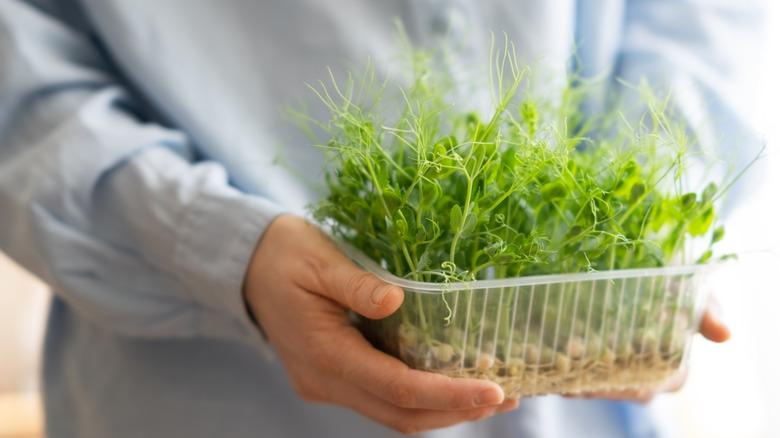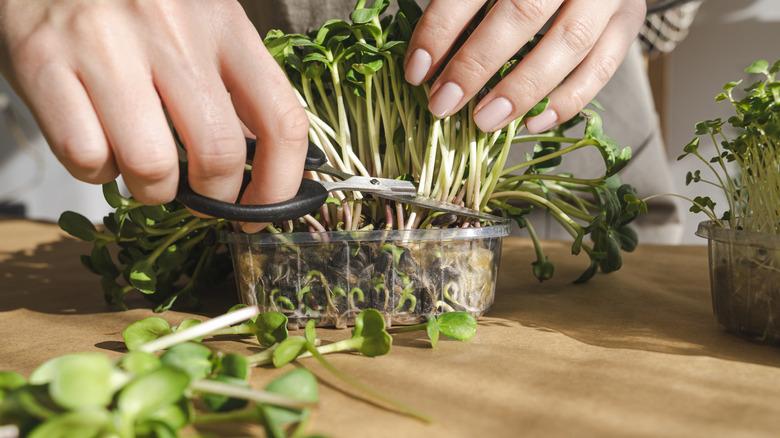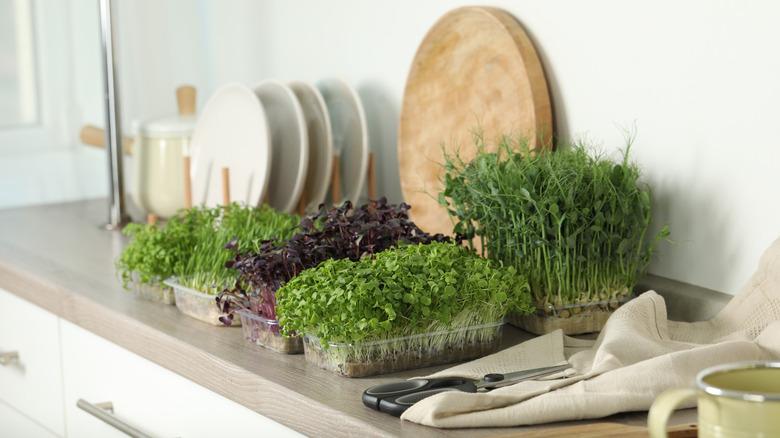The Best Type Of Seeds To Plant To Grow Microgreens
Ever had a sandwich or salad at a restaurant that had just a little something extra than your usual homemade lunches? Lettuce-like, but better? That's probably microgreens! Microgreens can be grown from a variety of plant types like broccoli and radishes, but instead of letting the seeds fully mature, you snip off those sprouting leaves to enjoy. Even if your local grocer doesn't have microgreens in stock, you can actually grow your own at home with a little know-how. We spoke with Sara Rubens, certified garden coach and founder of Seed to Sanctuary, in an exclusive interview for Hunker to get advice on which seed varieties perform best for beginners, and how to grow your own microgreens.
For those just beginning their microgreens journey, Rubens advises, "Some of the easiest seeds to start as microgreens are radish, broccoli, sunflower, pea shoots, and mustard." Unlike some other seed varieties, these "tend to have a consistent germination rate and require minimal equipment, making them ideal for someone just getting started." Plus, Rubens points out as an added bonus that, "These seeds germinate quickly, grow reliably, and have a mild to peppery flavor that appeals to most people." Other seed types like corn or beets can take longer to germinate, while herbs such as basil and dill can be unreliable for microgreen growth, according to Rubens. Because flavor and growing conditions can vary so much from species to species, "Knowing your seed types and what to expect from each is key to successful and safe microgreen gardening," says Rubens.
Why choosing the right seeds matters
In an exclusive interview with Hunker, Sara Rubens explains why it's important to understand the types of seeds you're planting for microgreens, saying, "The type of seed can significantly affect your results in terms of growth rate, flavor, texture, and even safety." Yes, microgreens aren't without their safety concerns, even when it comes to choosing seeds. Specifically, Rubens says to avoid growing microgreens from tomato, potato, or eggplant seeds as these are members of the nightshade family, which contain toxic alkaloids you certainly don't want to be ingesting.
To maintain your harvest and ensure you never deplete your microgreen crops, Rubens says it's key to have "4 to 6 different types of seeds on hand," as this "allows you to rotate crops, experiment with flavors and textures, and adjust for seasonal preferences." And by planting a variety of microgreen species, you're hedging your bets, because if one crop fails, there's a good chance you have another that will succeed. As Rubens puts it, "Having a variety of seeds also builds resilience—if one crop doesn't do well, another likely will." Cared for appropriately with this advice from Rubens, you'll have a steady crop of these edible leaves.
The best conditions for growing healthy microgreens
Even with all the right seed species, you've got to know how to create the perfect environment for them to thrive. In an exclusive interview with Hunker, Sara Rubens tells us, "Microgreens grow best in warm, bright conditions." To create a plant-filled kitchen window, opt for placing your seeds in a sunny windowsill, though Rubens says you may need supplemental grow lights if there's not enough direct sunlight. You'll also need "good airflow and a consistent temperature around 65–75 degrees Fahrenheit," says Rubens.
If you're planning on growing microgreens outdoors, Rubens advises that they successfully grow "in partial sun to full sun, depending on the season, but must be protected from heavy rain or direct scorching sun, especially in warmer climates." Plant the seeds in a shallow tray with well-draining, lightweight growing medium to prevent waterlogging — Rubens recommends a seed-starting mix or coconut coir. This allows the microgreens to emerge from the soil and keep from becoming drowned, which can lead to water mold and root rot, rendering your sprouts unsafe to eat. Also, be sure to do a little research before choosing your seeds so you know what to expect from each, as this can vary drastically. Rubens provides an example, saying "sunflower and pea microgreens are hearty and produce a large yield, while amaranth or basil grow more slowly and yield smaller harvests." Thankfully, with a variety of seed types, you should never be without a happy helping of microgreens.


